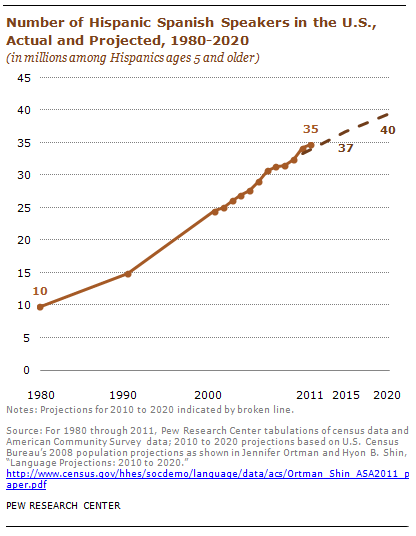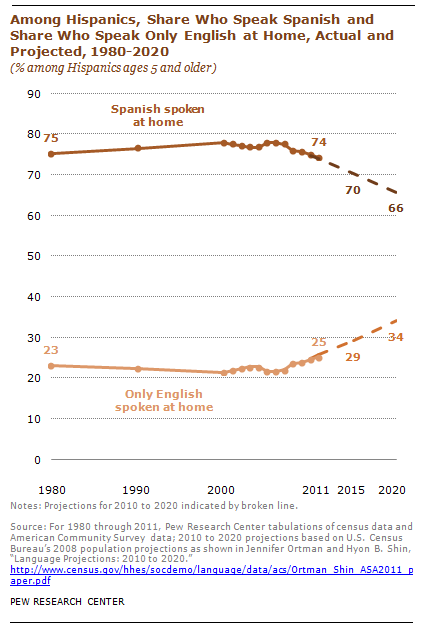
With more than 37 million speakers, Spanish is by far the most spoken non-English language in the U.S. today among people ages 5 and older. It is also one of the fastest-growing, with the number of speakers up 233% since 1980, when there were 11 million Spanish speakers. (The number of Vietnamese speakers grew faster, up 599% over the same period).
As Spanish use has grown, driven primarily by Hispanic immigration and population growth, it has become a part of many aspects of life in the U.S. For example, Spanish is spoken by more non-Hispanics in U.S. homes than any other non-English language and Spanish language television networks frequently beat their English counterparts in television ratings.
But what’s the future of Spanish?
According to a 2011 paper by U.S. Census Bureau Demographers Jennifer Ortman and Hyon B. Shin, the number of Spanish speakers is projected to rise through 2020 to anywhere between 39 million and 43 million, depending on the assumption one makes about immigration. Most of these Spanish speakers will be Hispanic, with Ortman and Shin projecting between 37.5 million and 41 million Hispanic Spanish speakers by 2020.
Ortman and Shin provide two other projections, both of which highlight the changing demographics of the nation’s Hispanic population and the rising importance of U.S. births rather than the arrival of new immigrants to Hispanic population growth.
Today, three-fourths of all Hispanics ages 5 and older speak Spanish. However, that share is projected to fall to about two-thirds in 2020. The share of Hispanics that speak Spanish reached 78% in the 2000s.
As the share of Hispanics who speak Spanish falls, the share that speaks only English at home is expected to rise. About a third (34%) of Hispanics will speak only English at home by 2020, up from 25% in 2010, according to Ortman and Shin.

The story of the Spanish language in the U.S. is still unfolding. Whether it follows the same pattern of decline in use as other non-English languages, such as Italian, German or Polish, remains to be seen. (The number of Italian, German and Polish speakers in the U.S. declined 55.2%, 32.7% and 25.9% between 1980 and 2010, even though the number of Americans who trace their ancestry to Germany, Poland or Italy grew over the same period.)
Nonetheless, the path that Spanish takes could be different. A 2012 Pew Research Hispanic Trends Project report showed 95% of Hispanic adults—including those born in the U.S.—said it is important that future generations of Hispanic speak Spanish. And today’s young Hispanics are more likely than their parents to say they hear messages about the importance of speaking Spanish. But among Hispanics, use of English when consuming news media, television entertainment, music or speaking it is on the rise.

